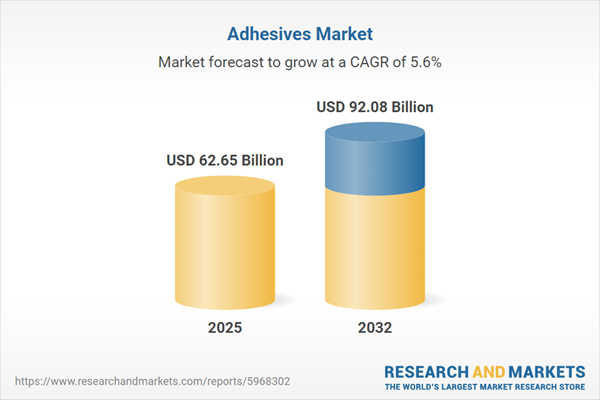Speak directly to the analyst to clarify any post sales queries you may have.
The global adhesives market is experiencing significant transformation, spurred by innovation, sustainability mandates, and changing supply chain dynamics. Senior decision-makers must navigate a multifaceted landscape as advanced chemistries, regulatory changes, and cross-sector collaboration fundamentally reshape the sector.
Market Snapshot: Adhesives Market Size and Growth Trajectory
The adhesives market grew from USD 59.35 billion in 2024 to USD 62.65 billion in 2025 and is sized for continued expansion, with a projected CAGR of 5.64%, reaching USD 92.08 billion by 2032. This sustained growth is underpinned by technology-driven product development, rising regulatory compliance needs, and increasing demand from sectors such as automotive, electronics, packaging, and construction. As competitive intensity rises, industry stakeholders will benefit from sharp insights into evolving trends, market segmentation, and the impact of external factors such as tariffs.
Scope & Segmentation of the Adhesives Market
This report offers extensive coverage of the adhesives sector, targeting technologies, product categories, regions, and leading companies. Segmentation provides clear navigation through the value chain and supports strategic planning.
- Product Form
- Liquid adhesives: Reactive, solvent-based, UV-curable, water-based
- Solid adhesives: Hot melt adhesive, pressure-sensitive adhesive
- Adhesive Chemistry
- Acrylic adhesives
- Epoxy adhesives
- Polyurethane adhesives
- Polyvinyl acetate adhesives
- Silicone adhesives
- Adhesive Technology
- Hot melt adhesives
- Reactive adhesives
- Solvent-based adhesives
- UV-curable adhesives
- Water-based adhesives
- End Use Industry
- Automotive
- Construction
- Electrical and electronics
- Furniture and wood
- Packaging
- Regional Coverage
- Americas: United States, Canada, Mexico, Brazil, Argentina, Chile, Colombia, Peru
- Europe, Middle East & Africa: United Kingdom, Germany, France, Russia, Italy, Spain, Netherlands, Sweden, Poland, Switzerland, United Arab Emirates, Saudi Arabia, Qatar, Turkey, Israel, South Africa, Nigeria, Egypt, Kenya
- Asia-Pacific: China, India, Japan, Australia, South Korea, Indonesia, Thailand, Malaysia, Singapore, Taiwan
- Leading Companies
- Henkel AG & Co. KGaA
- 3M Company
- H.B. Fuller Company
- Sika AG
- Arkema S.A.
- RPM International Inc.
- Ashland Global Holdings Inc.
- Eastman Chemical Company
- Avery Dennison Corporation
- Dow Inc.
Key Takeaways for Strategic Leaders
- Emerging materials such as bio-based polymers and advanced crosslinking agents are redefining performance standards and expanding application possibilities across multiple industries.
- Heightened environmental regulations drive investment in lower-emission chemistries, circular economy initiatives, and adhesive recyclability, fostering cross-sector innovation and compliance.
- Precision dispensing technologies and real-time process controls enhance quality consistency, while digitized operations support lean manufacturing and rapid material validation.
- Collaboration between chemical producers, equipment suppliers, and end users is intensifying to accelerate solution development and meet evolving customer requirements.
- Regional variations shape strategic responses: while North America prioritizes localized supply chains, Europe and the Middle East focus on regulatory compliance and circularity, and Asia-Pacific leads adoption of automation and precision technologies.
- Competitive advantage is increasingly built on digital services, proprietary technology pipelines, and collaborative development with OEMs rather than solely on product breadth.
Tariff Impact on the Adhesives Supply Chain
Recent United States tariffs on imported raw materials and finished adhesive products have disrupted global supply chains. To maintain supply reliability and cost competitiveness, businesses are adjusting procurement approaches, exploring local sourcing, or vertically integrating. These actions are driving higher investment in domestic infrastructure and increasing focus on flexible formulations able to adapt to cost fluctuations. Enhanced risk management and supply chain agility have become integral to sustaining industry performance in this climate.
Methodology & Data Sources
The research methodology integrates in-depth interviews with industry experts, comprehensive reviews of technical literature, and validation through third-party assessments and industry consortium reports. This mixed-methods approach ensures accurate, actionable insights on trends, technologies, regulatory shifts, and market impacts.
Why This Report Matters
- Delivers structured intelligence to inform long-term strategy, procurement decisions, and R&D investments for adhesives market stakeholders.
- Guides executive planning by benchmarking segment growth, identifying innovation pathways, and mapping global competitive landscapes.
- Equips leaders to anticipate regulatory changes, align sustainability goals, and optimize risk management in a rapidly evolving sector.
Conclusion
The adhesives market is rapidly evolving as technology, sustainability, and regional dynamics converge. Informed strategy and adaptable operations will be crucial for organizations seeking to lead in this competitive environment.
Additional Product Information:
- Purchase of this report includes 1 year online access with quarterly updates.
- This report can be updated on request. Please contact our Customer Experience team using the Ask a Question widget on our website.
Table of Contents
3. Executive Summary
4. Market Overview
7. Cumulative Impact of Artificial Intelligence 2025
Companies Mentioned
The companies profiled in this Adhesives market report include:- Henkel AG & Co. KGaA
- 3M Company
- H.B. Fuller Company
- Sika AG
- Arkema S.A.
- RPM International Inc.
- Ashland Global Holdings Inc.
- Eastman Chemical Company
- Avery Dennison Corporation
- Dow Inc.
Table Information
| Report Attribute | Details |
|---|---|
| No. of Pages | 197 |
| Published | October 2025 |
| Forecast Period | 2025 - 2032 |
| Estimated Market Value ( USD | $ 62.65 Billion |
| Forecasted Market Value ( USD | $ 92.08 Billion |
| Compound Annual Growth Rate | 5.6% |
| Regions Covered | Global |
| No. of Companies Mentioned | 11 |









